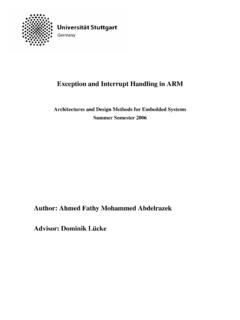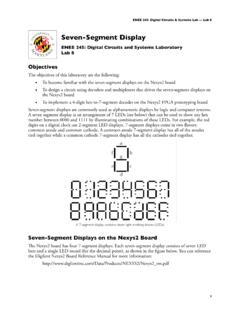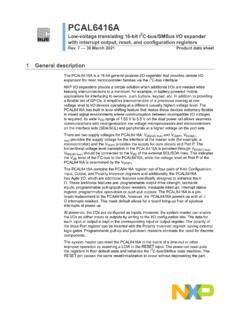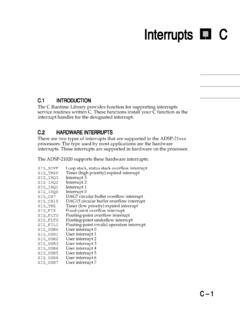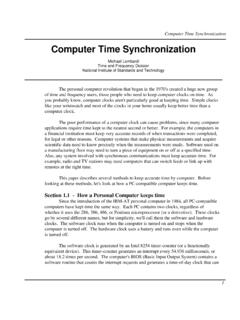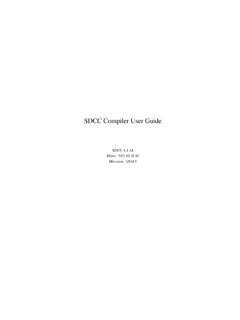Transcription of Interrupt handling - UMD
1 Interrupt handling Andrew N. Sloss 25th, 2001 Interrupt handling1 CHAPTER 1 Interrupt handlingHandling interrupts is at the heart of an embedded system. By managing the inter-action with external systems through effective use of interrupts can dramatically improve system efficiency and the use of processing resources. The actual process of determining a good handling method can be complicated, challenging and fun. Numerous actions are occurring simultaneously at a single point and these actions have to be handled fast and efficiently. This chapter will provide a practical guide to designing an Interrupt handler and discuss the various trade-offs between the different methods.
2 The methods covered will be as follows: Non-nested Interrupt handler Nested Interrupt handler Re-entrant nested Interrupt handler Prioritized Interrupt handlerEmbedded systems have to handle real world events such as the detection of a key being pressed, synchonization of video output, or handle the transmission and reception of data packets for a communication device. These events have to be han-dled in real time, which means an action has to take place within a particular time period to process the event. For instance, when a key is pressed on an embedded system it has to respond quickly enough so that the user can see a character appear-ing on the screen, without any noticeable delay.
3 If an inordinate delay occurs the user will perceive the system as being non-responsive. Interrupt handling2 Interrupt handlingAn embedded system has to handle many events. An event halts the normal flow of the processor. For ease of explanation, events can be divided into two types, planned and unplanned. Planned events are events such as a key being pressed, a timer producing an Interrupt periodically, and software Interrupt . Unplanned events are data aborts, instruction aborts, and undefined instruction aborts. In this chapter planned events will be called interrupts and unplanned events will be called excep-tions. When an event occurs the normal flow of execution from one instruction to the next is halted and re-directed to another instruction that is designed specifically to handle that event.
4 Once the event has been serviced the processor can resume normal execution by setting the program counter to point to the instruction after the instruction that was halted (except for data and prefetch abort, where instructions may have to be re-executed). At a physical level, an Interrupt is raised when the IRQ pin on the ARM core is set HIGH. The timing of the Interrupt source can either follow the clock of the proces-sor or not. When the Interrupt source follows the processor clock it is said to be a synchronous Interrupt source and when it does not follow the processor clock it is said to an asynchronous Interrupt source. See figure Figure Asynchronous and synchronous Interrupt sourcesNote: Internally all interrupts presented to the ARM core are synchronous.
5 An example of a asynchronous Interrupt is when a key is pressed the Interrupt pin on the processor is then set HIGH; identifying that an Interrupt has occurred. An example of a synchronous Interrupt source is when a real time clock or timer periodically sets the Interrupt pin an embedded system there are usually multiple Interrupt sources. These Interrupt sources share a single pin. This is due to the fact that there are only two Interrupt pins available on the ARM core. The sharing is controlled by a piece of hardware called an Interrupt controller that allows individual interrupts to be either enabled AsynchronousSynchronousInterrupt handling3or disabled. The controller provides a set of programmable registers, which can be used to read or write masks and obtain the Interrupt are two ways to trigger an Interrupt (edge or level).
6 Both rely in a change in voltage (See figure ). The change can either be on the rising edge or a change in voltage Interrupt triggers (Top - level, and Bottom - rising edge) From a software viewpoint the advantages and disadvantages are as follows: Rising Edge - Interrupt will be triggered as the signal goes HIGH, but will not be re-triggered until signal goes LOW and HIGH again. Level - Interrupt continuously active while signal is HIGH, so will keep re-enter ing Interrupt handler until signal is cleared. The Interrupt can occur even if the processor has not been powered : most ARM microcontrollers have a trigger method that is software config-urable. interrupts allow an embedded system to respond to multiple real world events in rapid time.
7 This is important for systems that have to handle complex mechanisms such as a large chemical plant or a mobile phone. To handle these demands a spe-cial purpose operating systems has to be designed so that the reaction time is kept to a minimum. These operating systems are given the general name of Real Time Operating Systems (RTOS). An RTOS can be applied to a broad range of consistency the following definitions will be used in this chapter: A Ta s k is an independent piece of code that can be executed at a particular address in memory and has a hard coded stack and heap. These are normally used in simple embedded systems without a memory management v3 v0 v0 vInterrupt handling4 Interrupt handling A Process is like a task except that it executes in its own virtual address space and has a stack and heap located within that virtual space.
8 Processes can be implemented on embedded systems that include a special device that changes address space and paging (Memory Management Unit). Threads are similar to processes but can easily be assigned to be executed on a different processor. For instance, a Symmetric Multi-Processor (SMP) systems can have different threads running on different processors. To handle multiple tasks a RTOS uses a number of different scheduling methods. Each method has different advantages and disadvantages depending upon the appli-cation. It is important that the tasks can communicate with each other, since they will probably have to share resources (memory or peripherals). The resources are normally protected by some mechanism, such as a semaphore (which will be dis-cussed in more detail later on in this chapter), so that only one task can access the resource at a time.
9 If the sharing of data is possible then a message passing system can be adopted to help communication between the various tasks. Message passing allows a task to pass data and control to another task without taking valuable resources away from the entire embedded system. The actual mechanism for swapping tasks is called a context switch. Preemptive RTOS context switching occurs periodically when a timer Interrupt is raised. The context switch will first save the state of the currently active task and then will restore the state of the next task to be active. The next task chosen depends upon the scheduling algorithm ( round robin) adopted. The example shown below in figure shows a simple embedded system with 3 Interrupt sources (a button, serial peripheral, and timer).
10 The button signal will occur when the button is pressed. These signals will be sent to the Interrupt control-ler. If the Interrupt controller masks this Interrupt then it will not be passed to the processor. Once an Interrupt occurs the software handler then will determine which Interrupt has occurred by reading the appropriate Interrupt control register. The Interrupt can then be serviced by an Interrupt service routine (ISR). Interrupt handling5 Figure Example of a simple Interrupt systemThe Interrupt handler is the routine that is executed when an Interrupt occurs and an ISR is a routine that acts on a particular Interrupt . For instance, an ISR for a key being pressed might determine which key has been pressed and then assign a character that is then placed into a keyboard buffer (for later processing by the operating system).
